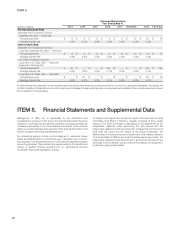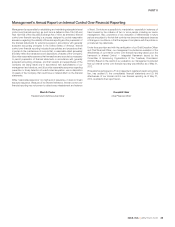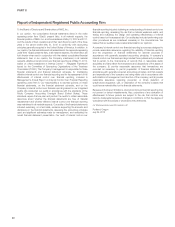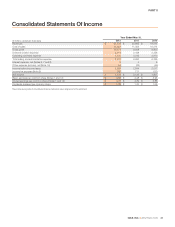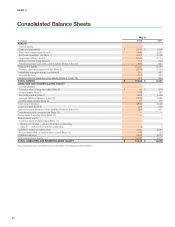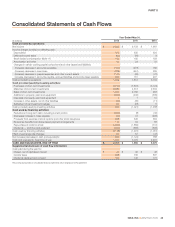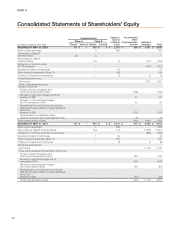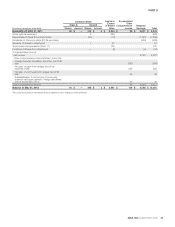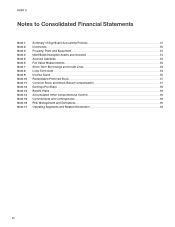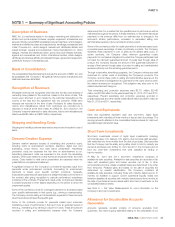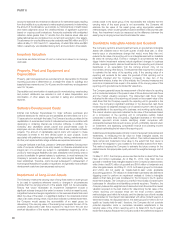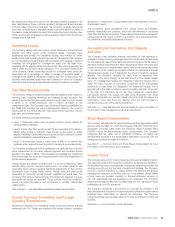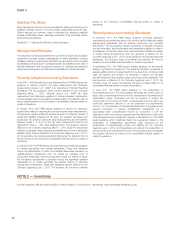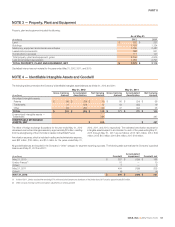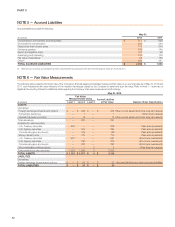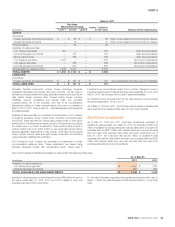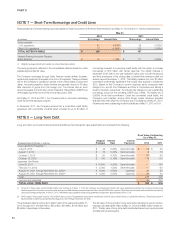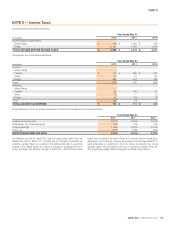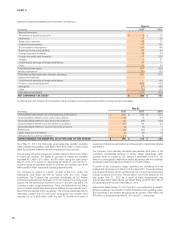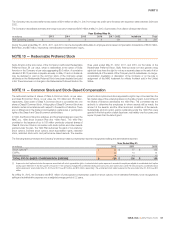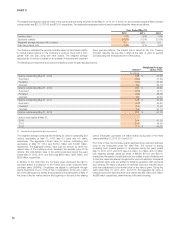Nike 2012 Annual Report Download - page 48
Download and view the complete annual report
Please find page 48 of the 2012 Nike annual report below. You can navigate through the pages in the report by either clicking on the pages listed below, or by using the keyword search tool below to find specific information within the annual report.PART II
accounts receivable and maintain an allowance for estimated losses resulting
from the inability of our customers to make required payments. In determining
the amount of the allowance, we consider our historical level of credit losses
and make judgments about the creditworthiness of significant customers
based on ongoing credit evaluations. Accounts receivable with anticipated
collection dates greater than 12 months from the balance sheet date and
related allowances are considered non-current and recorded in other assets.
The allowance for uncollectible accounts receivable was $95 million and $124
million at May 31, 2012 and 2011, respectively, of which $45 million and $50
million, respectively, was classified as long-term and recorded in other assets.
Inventory Valuation
Inventories are stated at lower of cost or market and valued on an average
cost basis.
Property, Plant and Equipment and
Depreciation
Property, plant and equipment are recorded at cost. Depreciation for financial
reporting purposes is determined on a straight-line basis for buildings and
leasehold improvements over 2 to 40 years and for machinery and equipment
over2to15years.
Depreciation and amortization of assets used in manufacturing, warehousing
and product distribution are recorded in cost of sales. Depreciation and
amortization of other assets are recorded in selling and administrative
expense.
Software Development Costs
Internal Use Software. Expenditures for major software purchases and
software developed for internal use are capitalized and amortized over a 2 to
10 year period on a straight-line basis. The Company’s policy provides for the
capitalization of external direct costs of materials and services associated with
developing or obtaining internal use computer software. In addition, the
Company also capitalizes certain payroll and payroll-related costs for
employees who are directly associated with internal use computer software
projects. The amount of capitalizable payroll costs with respect to these
employees is limited to the time directly spent on such projects. Costs
associated with preliminary project stage activities, training, maintenance and
all other post-implementation stage activities are expensed as incurred.
Computer Software to be Sold, Leased or Otherwise Marketed. Development
costs of computer software to be sold, leased, or otherwise marketed as an
integral part of a product are subject to capitalization beginning when a
product’s technological feasibility has been established and ending when a
product is available for general release to customers. In most instances, the
Company’s products are released soon after technological feasibility has
been established. Therefore, costs incurred subsequent to achievement of
technological feasibility are usually not significant, and generally most software
development costs have been expensed as incurred.
Impairment of Long-Lived Assets
The Company reviews the carrying value of long-lived assets or asset groups
to be used in operations whenever events or changes in circumstances
indicate that the carrying amount of the assets might not be recoverable.
Factors that would necessitate an impairment assessment include a
significant adverse change in the extent or manner in which an asset is used,
a significant adverse change in legal factors or the business climate that could
affect the value of the asset, or a significant decline in the observable market
value of an asset, among others. If such facts indicate a potential impairment,
the Company would assess the recoverability of an asset group by
determining if the carrying value of the asset group exceeds the sum of the
projected undiscounted cash flows expected to result from the use and
eventual disposition of the assets over the remaining economic life of the
primary asset in the asset group. If the recoverability test indicates that the
carrying value of the asset group is not recoverable, the Company will
estimate the fair value of the asset group using appropriate valuation
methodologies, which would typically include an estimate of discounted cash
flows. Any impairment would be measured as the difference between the
asset group’s carrying amount and its estimated fair value.
Identifiable Intangible Assets and Goodwill
The Company performs annual impairment tests on goodwill and intangible
assets with indefinite lives in the fourth quarter of each fiscal year, or when
events occur or circumstances change that would, more likely than not,
reduce the fair value of a reporting unit or an intangible asset with an indefinite
life below its carrying value. Events or changes in circumstances that may
trigger interim impairment reviews include significant changes in business
climate, operating results, planned investments in the reporting unit, planned
divestitures or an expectation that the carrying amount may not be
recoverable, among other factors. The impairment test requires the Company
to estimate the fair value of its reporting units. If the carrying value of a
reporting unit exceeds its fair value, the goodwill of that reporting unit is
potentially impaired and the Company proceeds to step two of the
impairment analysis. In step two of the analysis, the Company measures and
records an impairment loss equal to the excess of the carrying value of the
reporting unit’s goodwill over its implied fair value if any.
The Company generally bases its measurement of the fair value of a reporting
unit on a blended analysis of the present value of future discounted cash flows
and the market valuation approach. The discounted cash flows model
indicates the fair value of the reporting unit based on the present value of the
cash flows that the Company expects the reporting unit to generate in the
future. The Company’s significant estimates in the discounted cash flows
model include: its weighted average cost of capital; long-term rate of growth
and profitability of the reporting unit’s business; and working capital effects.
The market valuation approach indicates the fair value of the business based
on a comparison of the reporting unit to comparable publicly traded
companies in similar lines of business. Significant estimates in the market
valuation approach model include identifying similar companies with
comparable business factors such as size, growth, profitability, risk and return
on investment, and assessing comparable revenue and operating income
multiples in estimating the fair value of the reporting unit.
Indefinite-lived intangible assets primarily consist of acquired trade names and
trademarks. In measuring the fair value for these intangible assets, the
Company utilizes the relief-from-royalty method. This method assumes that
trade names and trademarks have value to the extent that their owner is
relieved of the obligation to pay royalties for the benefits received from them.
This method requires the Company to estimate the future revenue for the
related brands, the appropriate royalty rate and the weighted average cost of
capital.
On May 31, 2012, the Company announced its intention to divest of the Cole
Haan and Umbro businesses. As of May 31, 2012, Cole Haan had no
goodwill or indefinite-lived intangible assets on the Company’s balance sheet,
while Umbro had $70 million of goodwill and $164 million of trademark and
other intangible assets. As of May 31, 2012, both asset groups for Cole Haan
and Umbro did not quality as “assets-held-for-sale” under applicable
accounting guidance. The decision to divest these businesses was deemed a
triggering event to perform an impairment analysis of Umbro’s intangible
assets at that date and was considered in the Company’s fourth quarter
impairment analysis. The Company is currently in the process of preparing the
businesses for divestiture and identifying potential acquirers. Therefore, the
Company believes the weighted use of discounted cash flows and the market
valuation approach is the best method for determining the fair value of the
Umbro reporting unit because these are the most common valuation
methodologies used within its industry; and the blended use of both models
compensates for the inherent risks associated with either model if used on a
stand-alone basis. As discussed above, the asset groups for Umbro did not
qualify as “assets-held-for-sale”; therefore, the Company did not consider
potential disposition costs or cumulative translation adjustments in the
carrying value of the Umbro reporting unit in its fiscal 2012 fourth quarter
impairment analysis. Because the Company is still in the preliminary stages of
48


